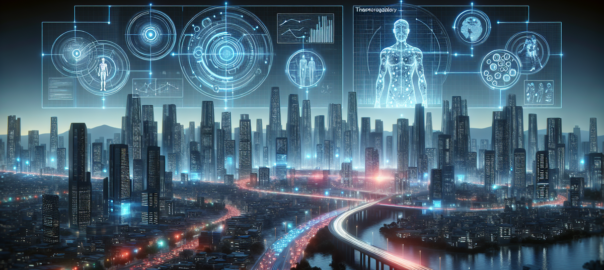Imagine a world where humanoid robots can decipher emotions, regulate their own “body” temperature, and execute tasks with the precision of a seasoned professional.
Recent advancements in robotics and artificial intelligence have propelled humanoid robots to new heights, making them integral to various industries. These robots, equipped with multimodal Large Language Models (LLMs), are showcasing remarkable improvements in dexterity and emotional intelligence. Check out our overview of NVIDIA’s pivotal role in AI progress here.
The thought of a humanoid robot struggling to choose the right temperature setting for its morning coffee is oddly amusing, yet it’s a glimpse into the future that’s nearer than you think. Who knew that one day your barista might need a firmware update?
Revolutionizing Work & Daily Life with Humanoid Robots Integration
The integration of humanoid robots with multimodal Large Language Models (LLMs) promises significant transformations in various industries like manufacturing and retail. By 2024, these robots are expected to perform complex tasks using both auditory and visual processing abilities, as seen with Boston Dynamics’ Atlas robot, capable of precision manipulation. Notably, companies such as BMW are employing robots like Figure 01 for automating labor-intensive tasks (source).
Simultaneously, innovations in thermoregulatory artificial skin for humanoids and prosthetic hands are emerging, as detailed in a study published in NPG Asia Materials. The artificial skin mimics human temperature distribution using a fiber network that simulates blood vessels, significantly enhancing human-robot interaction by offering a more lifelike touch (source).
Additionally, Apptronik’s Apollo humanoid robot, integrated with NVIDIA’s Project GR00T, aims to learn complex skills through diverse inputs like text and videos. Designed with user-friendly interaction, Apollo employs linear actuators to replicate human muscle movement and offers modular architecture adaptable to various platforms. Recently tested by Mercedes-Benz for automotive manufacturing, Apollo features hot-swappable batteries with over four hours of runtime, showcasing enhanced humanoid robot capabilities (source).
These advancements in humanoid robots’ emotional intelligence, thermoregulatory skin, and learning capabilities signify a future where robots not only elevate productivity but also enhance human experiences in everyday life.
Robotics Digest
1. Humanoid Robot Integration: Humanoid robots are being integrated into various industries, including manufacturing and retail. They are designed to perform complex tasks by using advanced technologies like multimodal Large Language Models (LLMs) and sophisticated dexterity, as seen in robots like Boston Dynamics’ Atlas and Figure 01.
2. Thermoregulatory Artificial Skin: This innovative skin for robots and prosthetics mimics human temperature through a network of heated water-carrying fibers, similar to blood vessels. By controlling the temperature and flow, it replicates human-like warmth and infrared signatures, enhancing realism and user comfort.
3. AI Advancements in Robotics: Artificial intelligence, particularly through projects like NVIDIA’s Project GR00T, is enabling robots like Apptronik’s Apollo to learn complex skills from various data inputs like text and videos. This allows robots to adapt to their environment and perform tasks with greater efficiency and human-like understanding.
Start-up Idea: Humanoid Robot Capabilities in Personalized Health Companions
Imagine a start-up that pioneers in delivering personalized health companion robots integrated with the latest AI advancements in robotics and thermoregulatory artificial skin. This unique service would cater to the burgeoning elderly population, providing invaluable assistance in both caregiving and healthcare monitoring. The product at the heart of this start-up is a humanoid robot capable of emotional intelligence, accurate biometrics monitoring, and real-time adaptability to patient needs through advanced sensors.
These lifelike companions would offer a spectrum of services, from daily health monitoring, medication reminders, and emergency response, to offering emotional support through conversation. The integration of thermoregulatory artificial skin would enhance comfort and trust, creating a nearly human-like touch experience.
Revenue streams would come from a subscription-based service model, partnering with healthcare providers, and offering tailored packages based on individual needs. Additionally, the collection of anonymized health data would contribute to advanced healthcare analytics, opening avenues for collaborations with medical research entities. This enterprise would not only relieve the healthcare industry but also transform senior care, ensuring a dignified and connected experience for the elderly.
Embrace the Future of Technology
Are you ready to be a part of the next big leap in robotics and AI? Now is the time to engage with these groundbreaking advancements shaping the future. Whether you’re a tech enthusiast dreaming of innovation, a startup founder looking for the next disruptive idea, or an executive aiming to stay ahead in the technology race, this is your moment to shine. Dive into these new possibilities and let’s blaze the trail towards an incredible, tech-driven future together!
FAQ
What makes humanoid robots like Apollo different from traditional robots?
Unlike robots designed for specific tasks, humanoids like Apollo are built for general-purpose use. Their ability to learn from diverse inputs, like human demonstrations, allows them to adapt to various tasks, making them more versatile than their predecessors.
How does thermoregulatory artificial skin enhance humanoid robots?
By mimicking human-like temperature through a system of heated fibers, this artificial skin creates a more natural feel and improves comfort for users interacting with robots, particularly in applications like prosthetics.
How capable are humanoid robots becoming in the workforce?
Advanced humanoids, such as Figure 01 deployed by BMW, are now capable of handling complex tasks previously requiring human dexterity. This shift signifies their growing potential to take on more intricate roles within various industries.
